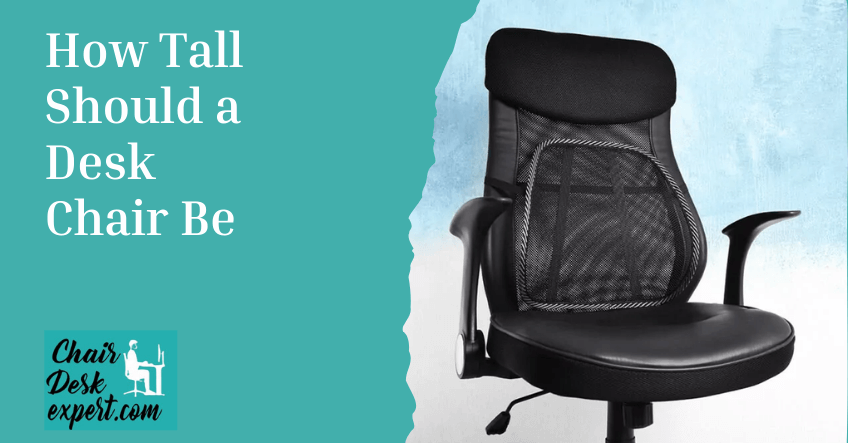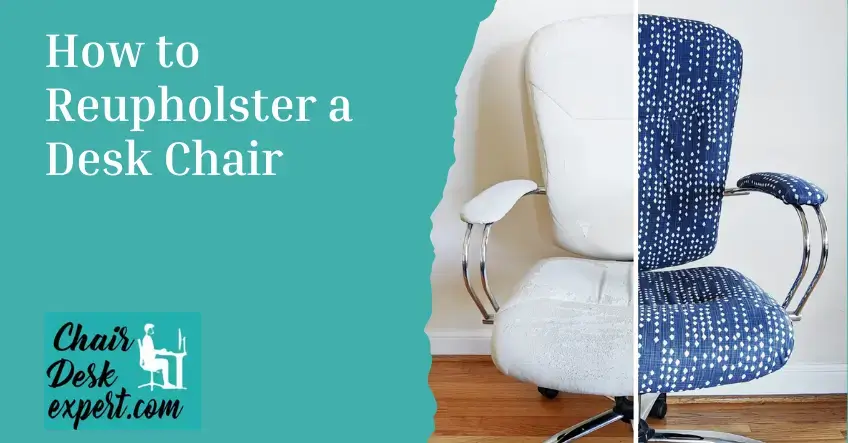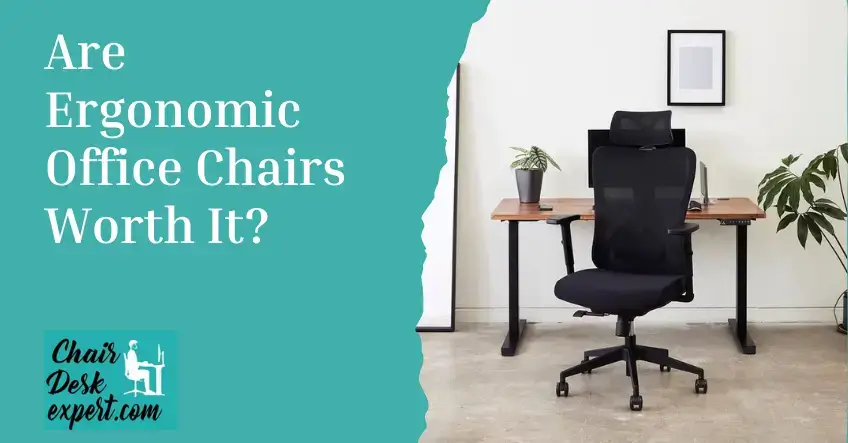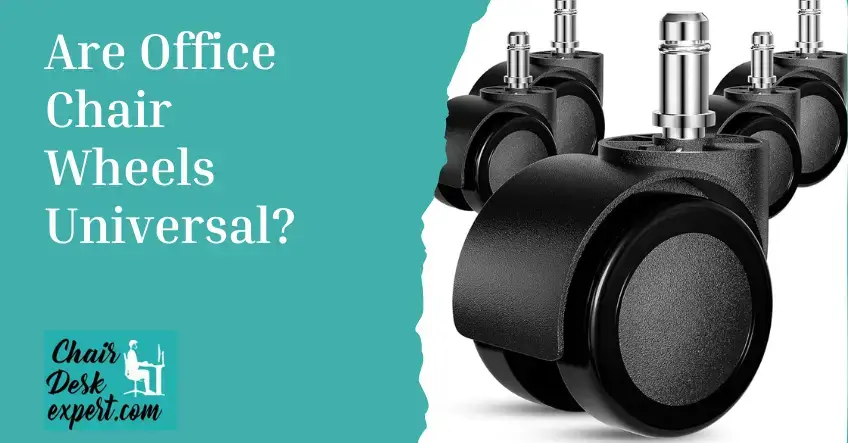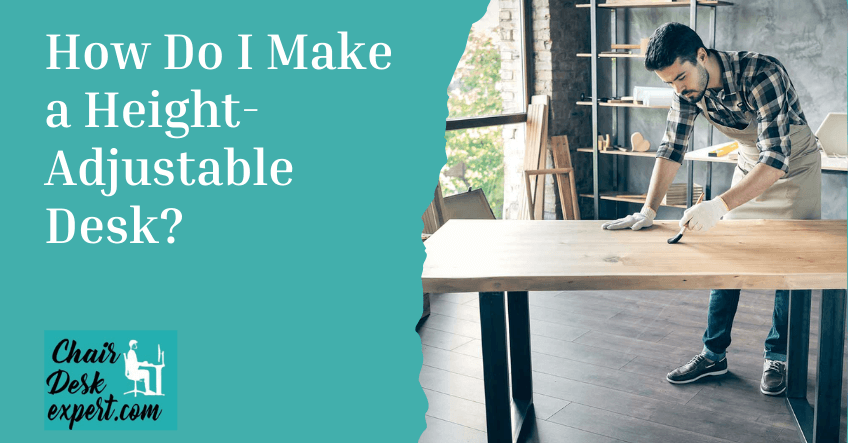If spending long hours at your desk has left you with back and neck pain, it may be time to rethink your ergonomic configuration. The height of your office chair is an important consideration.
Correct ergonomic chair height is a significant factor in maintaining an appropriate sitting posture that is both comfortable and healthy.
How tall should a desk chair be? Your office chair should have a height that enables you to keep your feet flat on the ground or use a footrest while ensuring that the knees are placed approximately at right angles.
However, the scope of ergonomic sitting does not end with chair height only. A lumbar support option, armrest heights, and seat pan depth customization features should also be provided by an adjustable ergonomic office chair.
In this guide, we will look at how to determine the correct ergonomic office chair height for you based on your body type and work style.
Adjusting your seat setup can help prevent pain in the back and neck and lead to more comfort and productivity throughout your working day.
How tall should a desk chair be -the Right Office Chair Height!
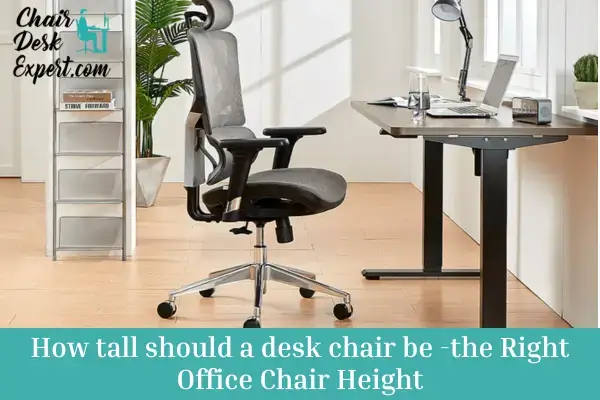
Optimum comfort and support while working require finding the right office chair height. Your individual needs dictate how you tailor your workspace ergonomically, as what may suit one person might not work for another.
To decide which chair height suits you better, consider your proportions, weight, and preferred working methods. Whether you like to sit up straight or lean back when working an adjustable chair can easily adjust accordingly.
A height adjustment feature is found in most chairs made for offices, which enables changing the seat’s position depending on personal body measurements.
As a rule of thumb, when adjusting its height, make sure it’s slightly below knee cap level while the feet are flat over the floor surface.
>> Read Also: How To Fix a Squeaky Desk Chair
Here’s a simple method to find your ideal chair height:
Sit on a chair so your legs bend inward at about a degree angle and your feet rest comfortably on the ground.
- Place measuring tape just beneath the heel vertically up toward the kneecap base.
- Remember or note this measurement as you compare your leg length standing or request help.
After finding your measurement, adjust the seat height on your chair accordingly. When sitting at the right height, your weight must be equally distributed over the seat cushions, and your feet should rest firmly on the ground. If there’s pressure behind your knees, then it means that the seat needs to go down!
By adhering to these guidelines and adapting your office chair heights to match your physique, you’ll develop an ergonomically well-designed space for work which will reduce discomfort or strain and enhance productivity.
Other Points of Adjustment: A Brief Takeaway
Backrest Support: Seek a seat with lumbar support that matches the natural curve of your lower back. Also, consider a backrest which adequately supports your upper back and preferably tilts at around 110 degrees.
Seat Tilt: Adjusting your seat’s tilt can help distribute the weight evenly and improve comfort. For most people, an average angle of approximately five degrees is appropriate.
Seat Depth: The depth of the seat should allow you to comfortably put your lower back on its back while sitting without causing any discomfort or pressure behind your knees. Some chairs have adjustable seat pans that slide forward or backwards to fit different depths.
Seat Width: Make sure that the width of the chair’s seat fits comfortably with your body, but do not make it narrow enough to squeeze your legs.
A general width of about 19.2 inches would do just fine, as armrests may be adjusted in terms of height for extra comfort.
Positioning Armrests: Whenever possible, choose armrests that restrict movement only slightly when typing while keeping them positioned correctly, especially near desks or keyboard trays where they need to be moved occasionally. Look for ones with a programmatic swivel and adjustable height or depth.
>> Read Also: How to Stop Office Desk Chair from Rolling
Tips and Tricks for a Good Fit
It may take more than simply adjusting one’s office chair for someone to have a perfect ergonomic setup in his office space; he might need to purchase another ergonomic chair altogether; he could also make some adjustments to his current one.
Here are some valuable tips/tricks addressing common issues associated with chair height, fit and ergonomics in an office setting:
When Your Seat is Too High: If you cannot touch the floor with both feet because the chair does not go low enough, get a footrest until you can afford to buy another one that will meet this requirement.
When Your Seat is Too Low: If you need a higher position but your office chair falls below the height of your kneecaps, a seat cushion will help resolve this temporarily until you can buy the right chair.
When Your Seat is Too Deep: If the seat back digs into the back of your knees because it is too deep, add a thick cushion to your backrest that will bring the seat in closer and make it more comfortable for now.
Armrests That Hurt: Discomfort from Armrests—Uncomfortable armrests that are not positioned well can lead to carpal tunnel syndrome. A gel pad on them, better armrests, or an upgrade to an adjustable ergonomic desk chair might be advised to overcome the discomfort.
Weight that isn’t Evenly Distributed: If you feel as if there is an unequal distribution of weight across your sitting area even though you have set up proper seat height, adjusting the tilt of your chair might correct this issue.
Incorrect Desk Height: Ensure that the table’s standing and sitting arrangements are ergonomically attuned. The best option would be an adjustable desk with a smooth transition between sitting and standing levels and saved heights for easy retrieval.
Wrong Screen Height: To avoid tiring out one’s neck or shoulders, computer monitors should be placed at eye level. Consider mountable monitor arms, which allow customization concerning screen height, especially when adjusting seating position, which alters this setting on the screen.
Key Chair Features to Consider
When choosing an office seat, selecting those with numerous points of change is fundamental. Hence, you obtain the proper ergonomic fit for your form. Moreover, other factors can be adjusted in a chair to enhance overall comfort and support.
For example, our Elevate Chair has eight different points at which one can make adjustments, including the following:
- Seat height adjustment with tilt tension control
- Armrest height adjustment
- Synchro-tilt mechanism with tilt lock
- Sliding seat adjustment
- Back height adjustment
- Adjustable seat pan depth and lumbar support
>> Read Also: Learn How to Reupholster a Desk Chair
This chair also comes with:
It has a woven mesh back that breathes well, thus enhancing comfort and promoting airflow while reducing heat buildup.
The waterfall seat edge design helps relieve pressure off the backs of your knees, thereby increasing circulation.
The high-density foam cushioning ensures even distribution of weight across the chair, thus making it strong enough to accommodate individuals weighing up to 350 pounds.
Complies with or exceeds durability requirements (BIFMA) necessary for business use for long-lasting performance and reliability
As such, it is fitted with five-star bases made of polymer as well as casters, thus ensuring stability on various floor surfaces.
On the other hand, if you need something more affordable, our task chairs provide four adjustment areas, such as height-adjustable armrests and adjustable tilt tension. Some other particulars are;
The adjustable padded lumbar support offers customized relief while properly aligning the spinal column.
The thick cushion made from high-density foam provides even weight-bearing capacity so that up to 275 pounds can be supported.
This model has polymer legs with five stars, making them highly durable and easy to glide across different floor types.
Remember, too much customization makes finding what you need in a chair difficult. Alternatively, consider purchasing a sit-to-stand desk for future-proof ergonomics throughout your office.
An adjustable desk is versatile and allows for sitting and standing postures that help promote proper posture and general health.
Conclusion
So, How tall should a desk chair be? Find the perfect height for your desk chair to maintain a good posture, comfort, and productivity during long working hours.
Adjust your chair to match it with your height and have an opportunity to improve your health. In addition, try considering other issues like armrests, backrests, and anything else that could give you proper body fitting about this desk chair.
Taking some moments while setting up the right suitable height of your desk chair will make you enjoy a healthier space later on.
FAQs!
What is the best chair height for knees?
While standing, adjust the chair’s height so that its highest point is just below your kneecap. This is supposed to allow your feet to touch down when seated. Whenever you feel pressure at the back of your seat, increase its height; if pressure is near the front of the seat, lower it.
What is the right armrest height for a desk chair?
Your elbows or forearms should rest comfortably on armrests without raising your shoulders too high (too tall), reaching over sideways to get an armrest (too wide), or slouching down towards them (too low). The standard armrests should be about equal to where bent points are placed.
How tall must the back of the chair be?
The depth of the lumbar curve in backrests ranges from 0.6-2 inches; all three heights were found equally effective for male subjects. A medium-level back offers complete shoulder support such as those found in car seats and office chairs, requiring elevated backs at approximately 26 inches tall, fitting 95th percentile males.
What if the seat is too high?
When chairs are too low, they can cause lower back pain, carpal tunnel syndrome, and rotator cuff injury in shoulder joints. Too high seating also leads to medial elbow pain, known as golfer’s elbow.

